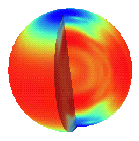 Internal Rotation
Internal Rotation Internal Rotation
Internal RotationThe goal is to measure the Sun's internal rotation rate as a function of latitude and depth, over as great an extent of the solar interior as possible, with the normal-mode frequencies available from SOI. The Sun's internal rotation and any other asphericities split the otherwise-degenerate frequencies of normal modes of the same (n,l) multiplet. The Internal Rotation Team Science Working Group (TSWG) will use the splitting arising from rotation: this is antisymmetric in m, provided that the Sun has a unique axis of symmetry. The measurement of the internal solar rotation will constrain theories of angular momentum transport in stellar interiors. In particular, measuring the rotation in the deep interior will determine whether the Sun has a fast-rotating core, which might be a relic of the Sun's faster rotation as a young star if the transport of angular momentum from the core is relatively inefficient. The determination of the rotation within the Sun's convective envelope will permit direct comparison with models of rotating, convective shells and with experimental realizations of such systems. Turbulent compressible convection constrained by rotation is likely to possess ordered structures and circulations, involving coherent plumes and vortices, large-scale mean flows and zonal jets. The inversion of the rotational splitting may therefore reveal jets and other pronounced shearing flows as components of the differential rotation profile both within the convection zone and in a region of penetration below.
Over the period of the mission, it is also our intention to utilize the continuous coverage in time to track temporal changes that may occur in the global rotation pattern.
It has been suggested from studies of flare activity that the deep interior of the Sun may rotate about an axis different from the axis of rotation inferred from the observed surface rotation. Rotation about a non-unique axis would give rise to hyperfine structure in the power spectra that would not be present if the Sun were purely axisymmetric. Such hyperfine structure might in principle be seen directly in the power spectra; on the other hand, if it were unresolved, it would contribute to the apparent linewidth and its presence might then be inferred from the apparent linewidths and fitted mode amplitudes. We shall therefore use power spectra and mode linewidths and amplitudes, in addition to the mode frequencies, to search for the signature of rotation about a non-unique axis. These effects will have to be disentangled from the effect of structural and magnetic asphericities, which will be considered by the Internal Structure TSWG. Thus close collaboration between the two teams is foreseen.
Suns Internal Rotation
Solar Rotation Rate
Touching the Heart of
the Solar Dynamo
This page last reviewed July 1, 2003